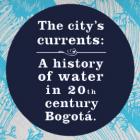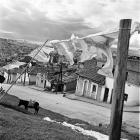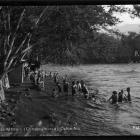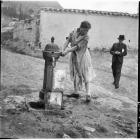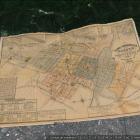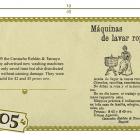Further reading
With no intention of providing an exhaustive literature review on the topics of urban environmental history, water history, waste history, and Bogotá history, we offer some reading suggestions based on the literature that we found most influential for this exhibition.
Urban environmental history
Urban Environmental History is a foundational branch of the general field of environmental history in Europe and North America, but less so in Latin America. Seminal references influencing the authors of this exhibition therefore reflect the unbalanced development of this perspective and its permeable frontier with urban and cultural geography. Literature that explores—both theoretically and empirically—the relationship between city and nature, includes the classic text by William Cronon. Nature’s Metropolis: Chicago and the Great West. New York: W.W. Norton, 1991; Nik Heynen, Maria Kaika, and Erik Swyngedouw, eds. In the Nature of Cities: Urban Political Ecology and the Politics of Urban Metabolism. London: Routledge, 2006; Andrew Isenberg, ed. The Nature of Cities: Culture, Landscape, and Urban Space. Rochester: University of Rochester Press, 2006; Stéphane Castonguay and Michèle Dagenais. Metropolitan Natures: Environmental Histories of Montreal. Pittsburgh: University of Pittsburgh Press, 2011.
The classic article by Christine Meisner Rosen and Joel Arthur Tarr. “The Importance of an Urban Perspective in Environmental History.” Journal of Urban History 20, no. 3 (1994): 299–310 still merits being read. The collection of stories in Dieter Schott, Bill Luckin, and Genevieve Massard-Guilbaud, eds. Resources of the City: Contributions to an Environmental History of Modern Europe. Aldershot: Ashgate, 2005 provides a glimpse into the European perspective. As for Latin America, in Shawn William Miller. An Environmental History of Latin America. New York: Cambridge University Press, 2007 one chapter is devoted to the “asphyxiated cities” of modern times. More specific references include Regina H. Duarte. “Urban Trees and Urban Environmental History in a Latin American City: Belo Horizonte, 1897–1964.” Global Environment 3 (2009): 120–53; Andréa Casa Nova Maia and Lise Sédrez. “Narrativas de um Dilúvio Carioca: Memória e natureza na Grande Enchente de 1966.” História Oral 14, no. 2 (2011): 221–54; Rosalva Loreto López, coord. Ciudad y naturaleza: Tensiones ambientales en Latinoamérica, siglos XVIII-XXI. Puebla: Instituto de Ciencias Sociales y Humanidades, Benemérita Universidad Autónoma de Puebla, 2012; and Antonio Elio Brailovsky, Buenos Aires, ciudad inundable: Porque está condenada a un desastre permanente. Buenos Aires: Editorial Capital Intelectual, 2010.
Of course, the extensive literature by Joel Tarr and Martin Melosi are inspiring and obligatory. We mention here Joel A. Tarr, ed. Devastation and Renewal: An Environmental History of Pittsburgh and its Region. Pittsburgh: University of Pittsburgh Press, 2003; Martin V. Melosi. Effluent America: Cities, Industry, Energy, and the Environment. Pittsburgh: University of Pittsburg Press, 2001, and by the same author, The Sanitary City: Urban Infrastructure in America from Colonial Times to the Present. Baltimore: John Hopkins University Press, 2000. For theoretical perspectives relevant to this exhibition, special mention should be given to the following references: Mikael Hård and Thomas J. Misa. Urban Machinery: Inside Modern European Cities. Cambridge, MA: MIT Press, 2010; Maria Kaika. City of Flows: Modernity, Nature, and the City. New York: Routledge, 2005; Simone Neri Serneri. “The Construction of the Modern City and the Management of Water Resources in Italy, 1880–1920.” Journal of Urban History 33, no. 5 (2007): 813–27; and Erik Swyngedouw. “Circulations and Metabolisms: (Hybrid) Natures and (Cyborg) Cities.” Science as Culture 15, no. 2 (2006): 105–21.
Water history in Latin America and beyond
Mexico is by far the best-explored Latin American case as far as water history is concerned. Alejandro Tortolero, Luis Aboites, Rosalva Loreto, and Sonya Lipsett-Rivera have been publishing extensively, but for this exhibition and as further readings the following serve as the essential references: Alejandro Tortolero Villaseñor. El agua y su historia: México y sus desafíos hacia el siglo XXI. Mexico City: Siglo XXI, 2000; Luis Aboites Aguilar. El agua de la nación: Una historia política de México (1888–1946). Mexico City: CIESAS, 1998; Rosalva Loreto López, ed. Agua, poder urbano y metabolismo social. Mexico City: Instituto de Ciencias Sociales y Humanidades, Benemérita Universidad Autónoma de Puebla, 2009; Sonya Lipsett-Rivera. To Defend Our Water with the Blood of Our Veins: The Struggle for Resources in Colonial Puebla. Albuquerque: University of New Mexico Press, 1999. Tortolero and Aboites also authored two chapters in the valuable volume edited by Christopher R. Boyer. A Land between Waters: Environmental Histories of Modern Mexico. Tucson: University of Arizona Press, 2012, while Tortolero has chapters in the books by Reinaldo Funes, ed. Naturaleza en declive: Miradas a la historia ambiental de América Latina y el Caribe. Valencia: Centro Francisco Tomás y Valiente, UNED Alzira-Valencia, Fundación Instituto de Historia Social, 2008 and Christian Brannstrom, ed. Territories, Commodities and Knowledges: Latin American Environmental Histories in the Nineteenth and Twentieth Centuries. London: Institute for the Study of the Americas, 2004. In this vein, Vera S. Candiani has also studied water technology and urban water history in Mexico with intriguing results, see for example her “Bourbons and Water.” In Jordana Dym and Karl Offen, eds. Mapping Latin America: A Journey Through Latin American Maps from the Columbian Encounter to the Present. Chicago: University of Chicago Press, 2011.
Water in Latin America is a rich topic for research. Dams, for which the compelling book by John R. McNeill. Something New Under the Sun: An Environmental History of the Twentieth-Century World. New York: W.W. Norton & Company, 2000 offers a global context, are particularly promising, as numerous dams, both large and small, were built from the Rio Bravo to Patagonia throughout the twentieth century. However, there is not yet any research for this region akin to the work of, for example, David P. Billington, Donald C. Jackson, and Martin V. Melosi. The History of Large Federal Dams: Planning, Design, and Construction in the Era of Big Dams. Denver: US Department of the Interior, 2005. Rivers have attracted some attention but there are still only few regional comparative studies, which is why Latin America is missing from comprehensive readings such as Christof Mauch and Thomas Zeller, eds. Rivers in History: Perspectives on Waterways in Europe and North America. Pittsburgh: University of Pittsburgh Press, 2008, or Terje Tvedt and Eva Jakobsson. A History of Water: Water Control and River Biographies. London: I. B. Tauris, 2006. And needless to say, Latin America is searching for its own Donald Worster to write a study comparable to his Rivers of Empire: Water, Aridity, and the Growth of the American West. New York: Oxford University Press, 1992. If we were to expand on political ecology or urban water conflict, the Latin American references would be abundant. For a general overview, see Erik Swyngedouw. Social Power and the Urbanization of Water: Flows of Power. Oxford: Oxford University Press, 2004.
Waste history
Waste history has recently become a field in its own right. Europe and the US have taken the lead, just as they do with global waste production itself. Essential readings include European case studies such as Sabine Barles. L’invention des déchets urbains: France, 1790–1970. Seyssel: Éditions Champs Vallon, 2005; Tim Cooper. “Challenging the ‘Refuse Revolution’: War, Waste and the Rediscovery of Recycling, 1900–1950.” Historical Research 81, no. 214 (2008): 710–31; Ercole Sori. Il rovescio della produzione: I rifiuti in età preindustriale e paleotecnica. Bologna: Il Mulino, 1999; Zsuzsa Gille. From the Cult of Waste to the Trash Heap of History: The Politics of Waste in Socialist and Post-Socialist Hungary. Bloomington: Indiana University Press, 2007; as well as studies of the US by Martin V. Melosi. Garbage in the Cities: Refuse, Reform and the Environment. Pittsburgh: University of Pittsburgh Press, 2005; Susan Strasser. Waste and Want: A Social History of Trash. New York: Henry Holt and Company, 2000; Joel A. Tarr. The Search for the Ultimate Sink: Urban Pollution in Historical Perspective. Akron: The University of Akron Press, 1996; Craig E. Colten. “Chicago’s Waste Lands: Refuse Disposal and Urban Growth, 1840–1990.” Journal of Historical Geography 20 (1994): 124–42. The book by John Scanlan. On Garbage. London: Reaktion Books, 2005 is an excellent theoretical introduction to the history of waste.
Appropriate historical works on waste are scant in Latin America, although this is a hot topic for urban studies and political ecology. Mexico must again be referenced: Rosalva Loreto López and Francisco Javier Cervantes Bello, eds. Limpiar y obedecer: La basura, el agua y la muerte en la Puebla de los Ángeles, 1650–1925. México City: Centro de Estudios Mexicanos y Centroamericanos, Embajada de Francia, 1994.
Urban, environmental, and other histories of Bogotá
Colombia and Bogotá are increasingly attracting scholars’ attention, but traditionally they have been somewhat invisible to the international academic community. As a result, most of the literature is in Spanish and published locally.
Fabio Zambrano, Germán Mejía Pavony, and Alberto Saldarriaga are among the most prolific authors on the urban history of Bogotá. Classic readings are: Germán Mejía Pavony. Los años del cambio: Historia urbana de Bogotá, 1820–1910. Bogotá: Centro Editorial Javeriano CEJA, 1999; Fabio Zambrano Pantoja. Historia de Bogotá. Siglo XX. Bogotá: Villegas Editores, Alcaldía Mayor de Bogotá, 2007; Alberto Saldarriaga Roa. Bogotá siglo XX: Urbanismo, arquitectura y vida urbana. Bogotá: Alcaldía Mayor de Bogotá, Departamento Administrativo de Planeación Distrital, 2000; and Julián Vargas Lesmes and Fabio Zambrano. “Santa Fe y Bogotá: Evolución histórica y servicios públicos (1600–1957).” In Pedro Santana, ed., Bogotá 450 años: Retos y realidades. Bogotá: Foro Nacional por Colombia, Instituto Francés de Estudios Andinos, 1988.
To put Bogotá in the context of Latin American urban history, useful references include the classic works by Richard Morse and Jorge E. Hardoy. Rethinking the Latin American City. Washington, D.C., and Baltimore: Woodrow Wilson Center Press, John Hopkins University Press, 1992; Jorge E. Hardoy, Urbanization in Latin America: Approaches and Issues. Garden City: Anchor Press, 1975; José Luis Romero. Latinoamérica: Las ciudades y las ideas. Medellín: Editorial Universidad de Antioquia, 1999; as well as more recent publications such as those by Venezuelan Arturo Almandoz. Planning Latin America’s Capital Cities, 1850–1950. London and New York: Routledge, 2002; “The Garden City in Early Twentieth-Century Latin America.” Urban History 31, no. 3 (2004): 436–52, and “Urban Planning and Historiography in Latin America.” Progress in Planning 65 (2006): 81–123. Silvia Arango’s recent book Ciudad y arquitectura: Seis generaciones que construyeron la América Latina moderna. Mexico City: Fondo de Cultura Económica, Consejo Nacional para la Cultura y las Artes, 2012 is also a beautiful contribution.
Environmental history has been developing quickly in Bogotá in the last decade. While no Colombian environmental history monograph exists, two volumes on the environmental history of Bogotá have been published: Jair Preciado Beltrán, Roberto Leal, and Cecilia Almanza. Historia ambiental de Bogotá, siglo XX: Elementos históricos para la formulación del medio ambiente urbano. Bogotá: Universidad Distrital Francisco José de Caldas, 2005, and Germán Palacio Castañeda, ed. Historia ambiental de Bogotá y la Sabana, 1850–2005. Leticia: Universidad Nacional de Colombia, Instituto Amazónico de Investigaciones IMANI, 2008.
The environmental perspective on urban infrastructure and practices related to water attracted a great deal of the attention of the younger generation of environmental historians and general historians alike. Important publications include Juan Camilo Rodríguez Gómez, coord. El agua en la historia de Bogotá. Bogotá: Villegas Editores, 2003; Julián Alejandro Osorio Osorio. El río Tunjuelo en la historia de Bogotá, 1900–1990. Bogotá: Alcaldía Mayor de Bogotá, Secretaria Distrital de Cultura, Recreación y Deporte, Observatorio de Culturas, 2007; Antonio Sánchez Gómez. Manos al agua: Una historia de aguas, lavado de ropas y lavanderas en Bogotá. Bogotá: Universidad Nacional de Colombia, 2010; Clara Inés Ángel. Agua-Fuentes en Bogotá. Bogotá: Instituto Distrital de Patrimonio Cultural, 2011; Maryluz Vallejo Mejía, ed. Talleres de crónica. Memorias del agua en Bogotá: Antología. Bogotá: Banco de la República, Pontificia Universidad Javeriana, Alcaldía Mayor de Bogotá, Archivo de Bogotá, 2011; and two books by Samuel Jaramillo González: Ciento veinte años de servicios públicos en Colombia. Bogotá: Centro de Investigación y Educación Popular CINEP, 1995 and Agua potable y alcantarillado en Bogotá: Realizaciones y limitaciones. Bogotá: Centro de Investigación y Educación Popular CINEP, 1990. Also of interest are María Clara Torres. El alcantarillado de Bogotá 1886–1938: Institucionalización de un problema ambiental. Tesis de Maestría en Medio Ambiente y Desarrollo, Instituto de Estudios Ambientales, Facultad de Ciencias Económicas y Administrativas, Universidad Nacional Colombia. Bogotá: Universidad Nacional de Colombia, 2010; Laura Cristina Felacio Jiménez. “La Empresa Municipal del Acueducto de Bogotá: Creación, logros y limitaciones, 1911–1924.” Anuario Colombiano de Historia Social y de la Cultura 38, no. 1 (2011): 109–40; and Ana María Carreira. “De las perturbadoras y conflictivas relaciones de los bogotanos con sus aguas.” Tabula Rasa 6 (2007): 263–85.
Useful input for this exhibition came from the socioeconomic analyses of everyday life in Bogotá, such as that presented in María del Pilar López Uribe. Salarios, vida cotidiana y condiciones de vida en Bogotá durante la primera mitad del siglo XX. Bogotá: Uniandes, 2011; Mauricio Archila Neira. Ni amos, ni siervos: Memoria obrera de Bogotá y Medellín, 1910–1945. Bogotá: Centro de Investigación y Educación Popular CINEP, 1989; and Miguel Ángel Urrego. Sexualidad, matrimonio y familia en Bogotá, 1880–1930. Bogotá: Fundación Universidad Central, Editorial Ariel, 1997.
The perspective provided by the social history of medicine has been influential to our exploration into the social uses of water. We found Carlos Ernesto Noguera’s publications particularly inspiring: Medicina y Política: Discurso médico y prácticas higiénicas durante la primera mitad del siglo XX en Colombia. Medellín: Fondo Editorial Universidad EAFIT, 2003, and “La higiene como política: Barrios obreros y dispositivo higiénico. Bogotá y Medellín a comienzos del siglo XX,” Anuario colombiano de historia social y de la cultura 25 (1998): 188–215. For how biopolitics played a role in the building of modern Bogotá, we liked Zandra Pedraza Gómez. En cuerpo y alma: Visiones de progreso y de la felicidad. Bogotá: Uniandes, 1999 and Santiago Castro-Gómez. Tejidos oníricos: Movilidad, capitalismo y biopolítica en Bogotá, 1910–1930. Bogotá: Editorial Pontificia Universidad Javeriana, 2009.
Historical cartography has been growing significantly in relation to Bogotá. Two atlases and a blog deserve to be mentioned: Alberto Escovar Wilson-White, Margarita Mariño, and César Peña. Atlas Histórico de Bogotá, 1583–1910. Bogotá: Corporación La Candelaria, Planeta Colombiana, Alcaldía Mayor de Bogotá, 2004; Marcela Cuellar Sánchez and Germán Mejía Pavony. Atlas Histórico de Bogotá: Cartografía 1791–2007. Bogotá: Alcaldía Mayor de Bogotá, Planeta Colombiana, 2007; and Razón Cartográfica: Noticias de la Red de Historia de las Geografías y Cartografías de Colombia, a blog created and maintained by Sebastián Díaz Ángel.
Finally, we drove our understanding of the ecological web of relations of Bogotá from two influential volumes by the German geographer Ernesto Guhl. La Sabana de Bogotá: Sus alrededores y su vegetación. Bogotá: Instituto Geográfico Agustín Codazzi IGAC, 1981 and Los páramos circundantes de la Sabana de Bogotá. Bogotá: Jardín Botánico José Celestino Mutis, 1982. Equally important are politically relevant works like Thomas Van der Hammen. Plan ambiental de la cuenca alta del Río Bogotá: Análisis y orientación para el ordenamiento territorial. Bogotá: Corporación Autónoma Regional de Cundinamarca CAR, 1998 and Germán Andrade, Diana Wiesner, and Fernando Remolina. “Assembling the Pieces: A Framework for the Integration of Multi-Functional Ecological Main Structure in the Emerging Urban Region of Bogotá, Colombia.” Urban Ecosystems 16, no. 4 (2013): 723–39.
- Previous chapter
- Next chapter







